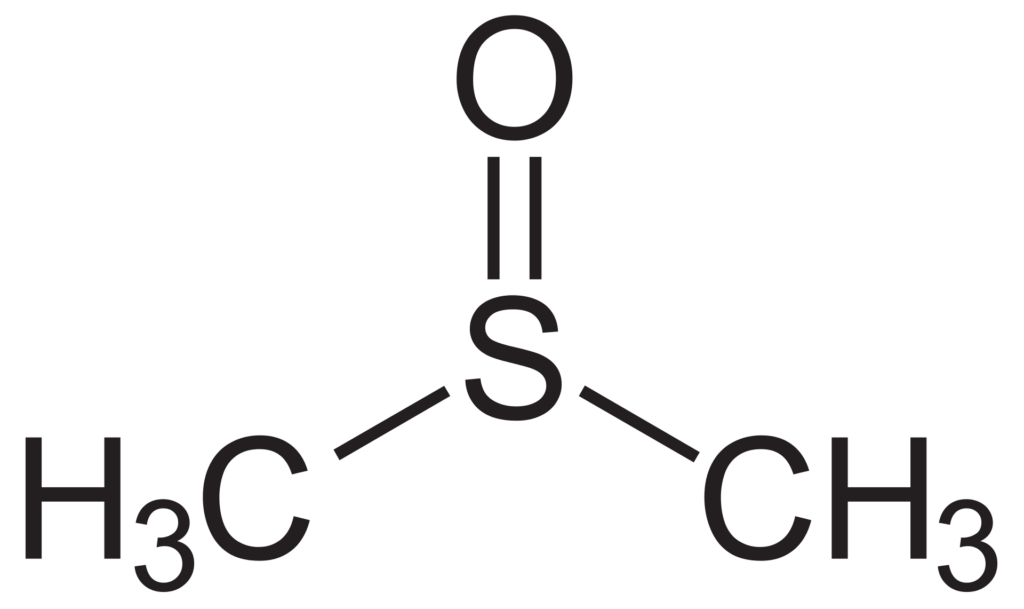What is DMSO?
Important information about DMSO (Dimethyl Sufoxide)
Do not use while pregnant or nursing. DMSO will detox the body so be mindful to start with a small amount and increase the dosage slowly. Drink plenty of pure water when using this product. Please only use on clean skin and avoid use while on any medications. Do a test patch on skin first to test for any aggravation.
Do not use any products on the skin that are toxic after applying DMSO for at least 30 minutes.
- Test patch first
- Start slow and work up to dose
- You cannot be allergic to elemental substances
- Reactivity to materials (plastics, rubber, silicone, metals)
- Redness, thickened skin, wrinkled skin, washing hands (water response), hives, burning, tingling, itching can occur but are temporary
- Combination with drugs
- Detox symptoms
- Movement of waste throughout the body quickly (temporal arteritis)
General Uses and Benefits
- Pain Relief/Nerve Block Agent/Analgesia (natural substitute to pain medication which can cause kidney dysfunction over time)
- Anti-Inflammatory Action
- Increases and Strengthens Tissue and Tissue Integrity
- Muscle Relaxant
- Penetration of the Skin/Membrane, Transport/Trans Dermal
- Bacterio-Static Action. DMSO doesn’t “kill” anything, rather it makes tissue up-regulate so well that it allows mobilisation of blood and other bodily substances away from the injury or problem area so that “bacteria” doesn’t need to come into the area to do that job. This means that it is also very helpful in ridding the body of any so-called “infection” we may get.
- Up-Regulates hormones in the kidneys to increase detoxification
- Clears up scars/dissolves scar tissue
- Collagen Deposits: If the collagen is incorrectly laid down/displaced in the body, DMSO will “re-frame” collagen and assist it to form properly, aiding in scar tissue healing.

Connective Tissue Actions

- DMSO assists with connective tissue disorders/fibrous protein amalgamations (cleans up & heals a lot of those issues). Blood is allowed to flow to affected areas unobstructed and quickly.
- Increase of blood flow (vasodilation/antagonism to platelet aggregation) meaning that in clotting disorders or issues with clotting, it will prevent large clots from forming (no need for medical blood thinners).
- Use after broken bones to accelerate healing and make sure blood doesn’t clot
- Prevents pulmonary embolisms (great in first aid natural (or non pharmaceutical) medicines)
- Uses water as a powerful travel agent inside the body
- Delivery of other substances throughout the body: blends with herbal substances or other natural medicinal substances to deliver those deeper into the tissues immediately upon use
- Used topically to heal rashes, skin blemishes, scars, acne, etc
- Detoxification of metals and plastic waste (teflon) classified as “forever chemicals” so that using DMSO regularly keeps our body clean
- Movement of materials (specific minerals/vitamins, etc) straight to target area
- Effect on serum cholesterol and down regulates bad cholesterol
- Can take certain malignant cells in cancer and reunite them with their healthy cell counterpart – fixing a cell that would normally be seen as “too far gone”, essentially repairing cells so that they are no longer damaged.
Cryoprotective
- Radioprotective (take it ahead of a scan/xray) so that it will protect your cells from oxidative damage. Protects from radiation of all kinds
- Protects from ischaemic injury (stroke, heart attack, etc) – It is used in major First Aid Action as using DMSO upon immediate signs of symptoms will prevent problem from escalating and repair damaged tissues
- Increases Oxygen delivery to cells

DMSO Major Therapeutic Properties

- Blocks pain by interrupting conduction in the small c-fibres, the non-myelinating nerve fibres
- Anti-inflammatory
- Anti bacterial, fungal and “viral” aka microbial control
- It transports all molecules (drugs, etc) across cell membranes
- It reduce the incidence of platelet thrombi (clots in vessels)
- It affects cardiac contractility by inhibiting calcium to reduce the workload of the heart
- It is a vasodilator, probably related to histamine release in the cells and to prostaglandin inhibition
- It softens collagen
- It is a scavenger of the highly reactive hydroxyl (-OH) free radical
- It stimulates the lymphatic system
- It is a potent diuretic
- It increases interferon formation (signalling protein)
- It stimulates wound healing
Actions Summary
- DMSO is a simple small molecule with unusual properties
An exothermic reaction occurs when DMSO is diluted with water (heat is generated) - Hydroxyl radicals (OH), which are free radicals (oxidants) are ubiquitous and highly injurious to cells – thus DMSO neutralizes (quenches) these free radicals
- DMSO substitutes for water in the living cell – it can destroy intracellular free radicals – something no other antioxidant can do!
- DMSO increases the permeability of cell membranes yielding a flushing effect of toxins from intracellular location to extracellular
- It is an antidote for allergic reactions
- It can penetrate any cell wall; thus it can travel straight to where most other chemicals can’t
- It has a very low index of any toxicity
- Reactions to DMSO can occur but they are uncommon
Specific Studies
In lab studies, DMSO has been shown to work as a cancer treatment for melanoma, colon cancer, leukaemia, lung cancer, ovarian cancer and lymphoma. There are two published human intravenous DMSO cancer studies by Dr. Hoang & his colleagues; one for prostate and one for gallbladder/bile duct cancer.
Intravenous DMSO is as effective as Mannitol and Dexamethasone in reversing cerebral edema and intracranial hypertension.
Amyloidosis (study on mice noting the broken fibres in urine, amyloid deposits removed from cells (misfolding of amyloid beta proteins due to chronic inflammation – can be related to Alzheimer’s, arthritis, diabetes)
The results of a study involving the use of DMSO in the treatment of patients with Alzheimer’s was presented at the Fourth International Conference on Alzheimer’s Disease and Related Disorders (results seen as early as three months, with best outcomes after six months of use).
